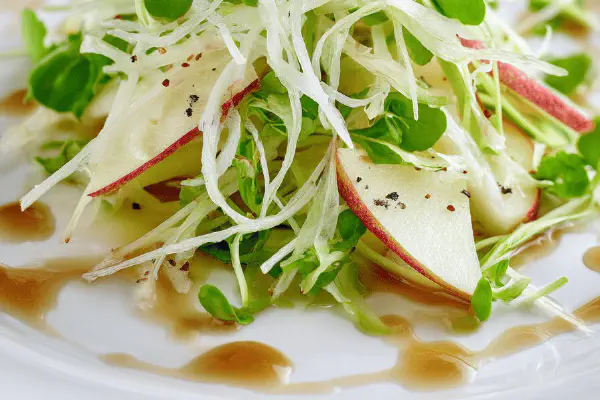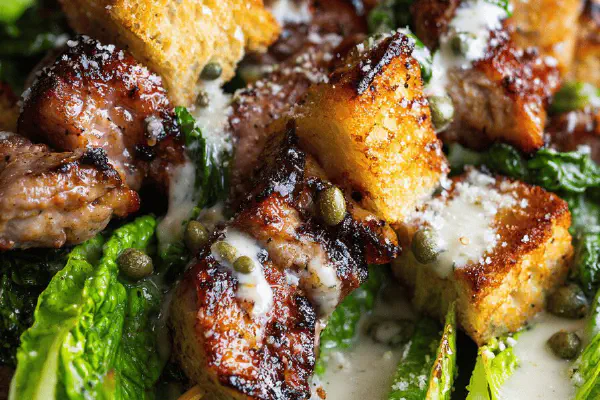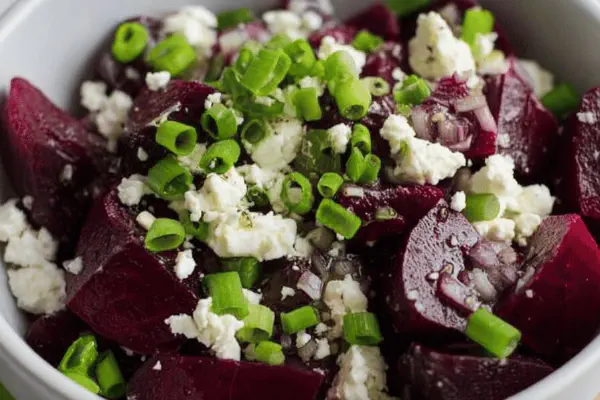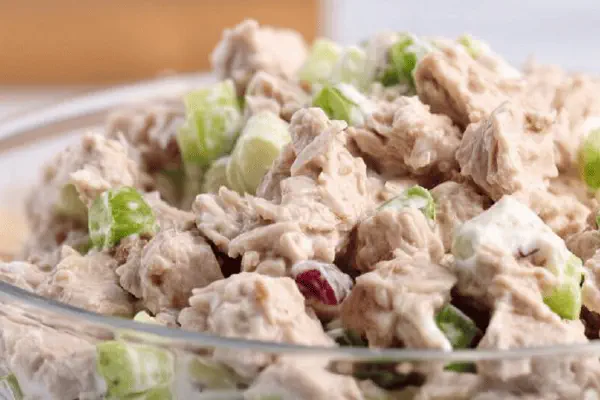Kohlrabi Apple Salad Remix
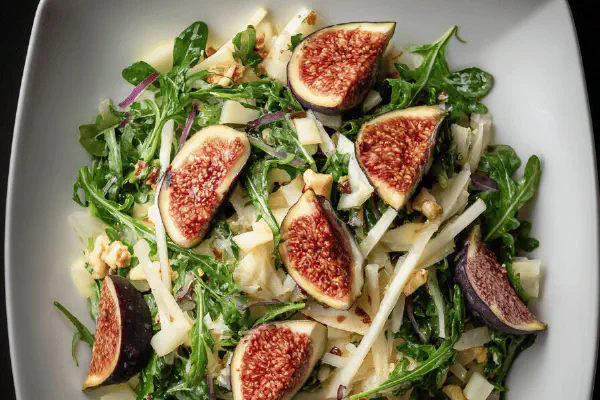
By Emma
Certified Culinary Professional
Ingredients
- 1 kohlrabi, peeled and thinly sliced on a mandoline
- 45 ml lemon juice (3 tbsp)
- 0.5 ml salt (1/8 tsp)
- 1 pear, cored and diced small
- 60 g frisée or bitter greens (2 cups packed)
- 70 g fresh figs, halved
- 30 g Manchego cheese shavings (1/4 cup)
- 1 small plum, cut into thin wedges
- 20 ml olive oil
- 10 ml walnut oil
- 15 ml apple cider vinegar
About the ingredients
Method
- Start by layering kohlrabi slices in a bowl. Toss with lemon juice and salt; massaging slightly to wake up the veggies. Let sit about 10 to 12 minutes, until edges soften but crisp remains.
- While kohlrabi is doing its thing, dice pear into neat small cubes. Toss gently with remaining lemon juice to stop browning; drain excess juice if any pools.
- Drain liquid off kohlrabi; add to pear. Now fold in frisée, figs, and plum wedges carefully, keeping as much shape and crunch intact.
- Whisk olive oil, walnut oil, and apple cider vinegar; drizzle over salad. Finish by scattering Manchego shavings. Taste and adjust salt if needed. Serve immediately for freshest texture.
- Watch the kohlrabi for slight translucence but no sogginess before draining; this ensures crisp but not raw bite. Avoid overdressing which wilts greens and dulls bright fruit flavors.
Cooking tips
Chef's notes
- 💡 Thin slicing with mandoline is crucial. Uniform slices mean even soak and consistent texture. Without mandoline, sharp knife but shave thin thin, keep size consistent. Thickness impacts soak time; too thick means raw, too thin mushy. Watch edges for translucence Not too long in lemon and salt or softens past snap. Drain liquid well after soak to avoid soggy salad; excess water dulls dressing impact.
- 💡 Pear replaces apple here, less acidic, juicier sweetness. Dice small, keeps bite manageable and prevents overwhelming pear flavor. Toss pear gently in reserved lemon juice to slow browning enzymes. Drain pear too or risk watery mix. Substitute options: Honeycrisp apple works but reduce lemon juice since apple can be tart. Plum wedges optional but add sweet tang and color contrast; skip if textures conflict with preference.
- 💡 Figs bring earthiness. Use fresh halved where possible for texture and flavor balance. Seedless grapes can fill in seasons when figs unavailable; dried apricots chopped too but soften texture, shift sweetness profile. Add fruits last and fold gently; avoid bruising or pureeing fruit with greens. This preserves individual texture and mouthfeel contrast.
- 💡 Dressing balance is key here. Combine olive oil and walnut oil for rich aroma that doesn’t overpower. Walnut oil simulates nutty flavor without nuts, useful for allergy-friendly version. Apple cider vinegar replaced white wine vinegar for softer acidity, better fruit alignment. Whisk well before drizzle; oil-vinegar separate fast otherwise. Avoid overdressing or greens wilt, fruit dulls. Less is more, mindful splash.
- 💡 Salt enhances brightness not just seasoning; measured small amounts as acid and fruit natural sweetness create layers. Taste salad at finish before adjustment. Timing matters; kohlrabi soak varies by slice thickness and freshness. Watch texture not clock. Over-soaked turns mush, under-soaked tastes raw. Cool room temperature best for serving, warmth releases aromas but fridge cold flattens tastes. Fresh cracked pepper or microgreens optional finish for bite and color pop.
Common questions
How long soak kohlrabi?
Depends on thickness. Watch edges turn translucent, center still firm. Usually 10-12 mins. Not too short raw bite, not too long limp mush. Drain well after. If no time, slice thinner, less soak.
Can I swap pear for apple?
Yes but apple more acidic, less juicy. Use crisp variety, slice thin, reduce lemon juice to avoid overpower. Honeycrisp best for replacing here. Plum wedges optional, more tart if used.
What if salad too soggy?
Drain kohlrabi super well after soak. Excess water ruins texture and dressing. Avoid over-soaking. Use mandoline or sharp knife thin slices for quicker soak. Serve immediately or within short rest.
How to store leftovers?
Cover and refrigerate. Eat next day best for crunch but expect slight softening. Keep dressing separate if possible or toss fresh. Avoid freezer for fresh salad. Wrap tightly to retain aroma but not too cold, fridge chill dulls flavors.
